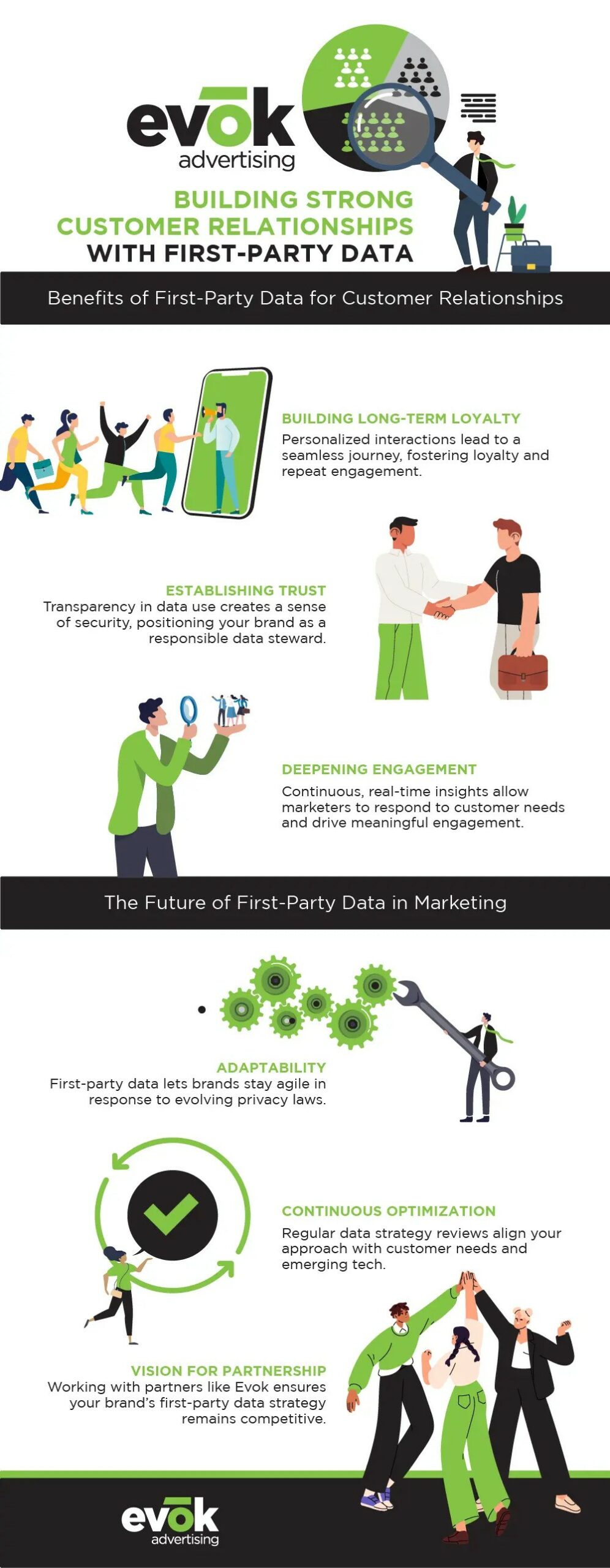
What Is First-Party Data: A Marketing Guide for Building a First-Party Data Strategy
The rules of data-driven marketing are changing fast, thanks to rising regulations and the diminishing accessibility of third-party data. Chief Marketing Officers (CMOs) now face the challenge of reimagining how they connect with and understand their customers. For marketers committed to staying ahead, first-party data has emerged as a powerful tool that fuels insights and enables more precise, impactful, and trust-centered marketing strategies. Those using first-party data for key marketing functions achieved up to a 2.9X revenue uplift and a 1.5X increase in cost savings, according to Google.
Building a first-party data strategy involves more than simply collecting information; it’s about gathering the right data points, creating enriched customer profiles, and leveraging behavioral insights to deliver the hyper-personalized experiences your audience expects. By the end of this guide, you’ll have a roadmap for a first-party data strategy that aligns with your business goals, enhances your marketing efforts, and positions your brand as a leader in personalized, trust-based customer relationships.

What Is First-Party Data?
First-party data is data collected directly from your audience as they engage with your brand through owned digital channels, such as your website, mobile apps, and email interactions. Unlike third-party data, which is gathered and sold by external vendors, first-party data is information your brand gathers firsthand, making it more accurate, relevant, and privacy-compliant.
Types of First-Party Data
This valuable data encompasses a variety of touchpoints, offering insight into who your customers are and how they interact with your brand. Key examples include:
- Demographic Information: Basic details like age, location, and preferences often collected when users create accounts or fill out profiles.
- Behavioral Data: Insights into how users navigate your website or app—what pages they visit, how long they stay, and what products they interact with.
- Purchase History: Details of past purchases or browsing history reveal preferences and buying patterns.
- Feedback and Survey Responses: Direct responses from customers, offering insights into their opinions, needs, and pain points.
- Loyalty Program Engagement: Information from loyalty or rewards programs that reflects purchase frequency, preferred products, and overall customer satisfaction.
By capturing these data points, brands can better understand their customers’ needs and behaviors, making it easier to create tailored, meaningful interactions.
Why First-Party Data Matters
The shift toward first-party data goes beyond just adapting to privacy regulations—it’s about building long-term, trust-based relationships. Consumers say a brand’s honesty about how data is used engenders trust, ranking higher in importance than great products or positive reviews. Moreover, first-party data provides valuable insights that help brands design strategies with a deeper understanding of customer needs, leading to more effective, impactful campaigns.
For brands seeking a competitive edge, first-party data offers a clearer, more personalized approach to understanding customer journeys. It allows for more accurate segmentation, predictive insights, and real-time personalization, creating a stronger, customer-centered marketing strategy that enhances engagement and drives business growth.
The Importance of a First-Party Data Strategy

With the digital landscape evolving rapidly, a first-party data strategy is no longer optional for brands aiming to stay competitive. It’s an opportunity to establish customer trust, understand their behaviors, and deliver consistently relevant experiences.
Why First-Party Data Matters for Marketers
88% of marketers say gathering first-party data is more important to organizations than two years ago. First-party data provides advantages beyond compliance; it empowers brands to engage more meaningfully with their customers. When used strategically, it offers a direct line to valuable insights that are harder to obtain from third-party data. Here’s why it’s essential:
- Competitive Differentiation: First-party data offers insights unique to your brand, giving you an edge in understanding your specific audience. This level of personalization helps you stand out in a crowded market.
- Increased Accuracy: Data collected directly from customers is more reliable, enabling better targeting and reducing wasted ad spend on ineffective campaigns.
- Enhanced Customer Relationships: First-party data provides direct insight into customers’ preferences, behaviors, and pain points, helping build trust and loyalty by enabling a personalized approach that customers increasingly expect.
Real-World Impact of a First-Party Data Strategy
Implementing a first-party data strategy strengthens every aspect of your marketing efforts. For example, brands that use first-party data to understand purchase behaviors can better anticipate needs, improve retention through personalized offers, and optimize customer lifetime value. This strategy is especially valuable in a world where customer loyalty is increasingly tied to how well a brand meets personal expectations.
Key Data Points and Collection Methods

Collecting first-party data requires an intentional approach, as its value depends on its relevance and accuracy. Let’s examine some high-impact data points and the most effective methods for gathering them.
Valuable Data Points to Collect
Specific data points offer exceptional value in shaping a data-driven strategy:
- Behavioral Data: Knowing how customers interact with your website or app—what they search, where they linger—provides insights into interests and potential areas for conversion.
- Purchase History: Analyzing past purchases can highlight customer preferences, helping to tailor recommendations and offers.
- Loyalty Program Engagement: Loyalty programs provide insight into repeat customers, preferred products, and high-value segments.
Effective Collection Methods
- Mobile Apps & Websites: Optimize digital channels for ease of interaction, ensuring data collection is frictionless and user-friendly. For example, implementing smart forms or interactive quizzes can enhance user engagement while gathering valuable insights.
- Loyalty Programs: Encourage customers to opt-in for loyalty programs, providing exclusive benefits in exchange for data that improves personalization efforts.
- Surveys and Feedback Loops: Proactively seeking customer feedback through surveys and reviews captures direct input that reflects customer sentiment and emerging needs.
Building a First-Party Data Strategy

Creating a first-party data strategy involves more than collecting information; it requires clear objectives, efficient processes, and a customer-centric approach to data handling.
Step 1: Define Objectives
To maximize the impact of first-party data, start by defining your goals. Are you looking to deepen engagement, increase conversions, or improve retention? Setting specific goals allows you to align data collection with outcomes that enhance your marketing strategy.
Step 2: Map Data Collection Points
Identify key touchpoints along the customer journey where you can capture relevant data—such as during account sign-ups, purchase checkouts, or app interactions. This ensures you’re gathering data at moments when customers are most engaged.
Step 3: Integrate with Customer Profiles
Aggregating data from multiple sources can help build comprehensive customer profiles. For example, combining purchase history, behavioral data, and survey feedback provides a multidimensional view of each customer, allowing for highly tailored marketing efforts.
Step 4: Ensure Compliance and Build Trust
Data privacy is non-negotiable. Ensure all data collection complies with legal requirements and is transparent to customers. Explain how their data will enhance their experience and provide easy opt-out options. This transparency builds trust, making customers more likely to share valuable insights.
Leveraging First-Party Data for Personalization

Personalization is where first-party data truly shines, allowing brands to create experiences that resonate on a personal level.
Creating a Personalized Experience
Personalization means more than addressing customers by name; it’s about anticipating their needs and delivering relevant content. First-party data empowers CMOs to tailor offers and recommendations based on customers’ preferences and behaviors. This leads to higher engagement rates, increased satisfaction, and stronger loyalty.
Behavioral Data Insights
Behavioral data, like browsing history or search patterns, provides actionable insights that enable predictive marketing. For instance, if customers frequently browse certain product categories, you can target them with special offers or reminders about similar items. By anticipating needs, you enhance the shopping experience and drive conversions.
The Role of AI and Machine Learning
AI and machine learning enhance the effectiveness of first-party data by identifying patterns and making predictions. By leveraging these technologies, brands can implement real-time personalization, such as adjusting website content based on a customer’s interests or recommending products based on past purchases. This creates a dynamic, responsive marketing experience that feels custom-made for each user.
Moving Forward with an Audience-Centric Data Strategy
First-party data is the cornerstone of a modern marketing strategy that aligns with today’s privacy, transparency, and personalization expectations. With a well-designed first-party data strategy, CMOs can gain valuable insights into their audiences and foster deeper connections that drive long-term loyalty and growth.
Ready to elevate your marketing approach with first-party data? Reach out to our team to learn how we can help you craft a strategy that turns insights into impact, setting your brand apart in an increasingly competitive landscape.